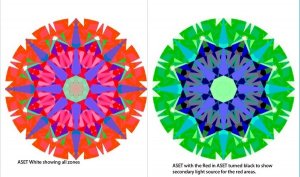I was trying to explain to a friend the idea behind ASET images, but I found myself unable to justify the reasoning that red light is "better"/"intense" light, and that green light is "weaker" light. I'm going to put a disclaimer first that I am NOT trying to discredit anyone. I am just trying to learn. If you look online at some of the most reputable sources, you'll see something along the lines of:
AGS Site:
"Red represents light coming from angles where there is likely to be bright, direct sources of illumination in most viewing environments."
Whiteflash:
"...the most direct light entering a diamond will generally come from the higher angular ranges".
Brian Gavin Youtube:
Too long to quote. But the gist I got was the same as others, that most intense light was from above.
It seems to me that they've all assumed the viewing angle is roughly the same as the angle of the strongest light source (e.g. coming from behind my head). I agree this is the case if I'm looking down at a diamond with the table pointing towards the sun or lights above me, but what about real life situations. I want it to look fabulous with the diamond tilted in any direction, not just to me, but to other people! I could be holding onto a pole in the subway, with the lights above me, and my hand and diamond table facing the wall. I want that person beside me to think, damn, they've got a shiny rock!
But does the ASET image tell me anything about this scenario? The ASET scope is designed under the assumption that the strongest light source is 45-75 degrees relative to the diamond table plane when you look directly at the table. Can I infer what will happen if I'm still looking directly at the table, but the strongest light source is coming from 10 degrees relative to the table plane, with only weak ambient light from the 45-90 degree region?
AGS Site:
"Red represents light coming from angles where there is likely to be bright, direct sources of illumination in most viewing environments."
Whiteflash:
"...the most direct light entering a diamond will generally come from the higher angular ranges".
Brian Gavin Youtube:
Too long to quote. But the gist I got was the same as others, that most intense light was from above.
It seems to me that they've all assumed the viewing angle is roughly the same as the angle of the strongest light source (e.g. coming from behind my head). I agree this is the case if I'm looking down at a diamond with the table pointing towards the sun or lights above me, but what about real life situations. I want it to look fabulous with the diamond tilted in any direction, not just to me, but to other people! I could be holding onto a pole in the subway, with the lights above me, and my hand and diamond table facing the wall. I want that person beside me to think, damn, they've got a shiny rock!
But does the ASET image tell me anything about this scenario? The ASET scope is designed under the assumption that the strongest light source is 45-75 degrees relative to the diamond table plane when you look directly at the table. Can I infer what will happen if I'm still looking directly at the table, but the strongest light source is coming from 10 degrees relative to the table plane, with only weak ambient light from the 45-90 degree region?








300x240.png)